Everyone has their own opinions on the secret to whitetail deer movement, and when the best time to be in the woods is. It also does not take long to find two differing opinions about when those times are. Obviously, everyone cannot be right. So, when are whitetail deer the most active? What factors influence how active they are? Well to start off, there are many things to consider when pinpointing what time deer will be most active in your area. Plus, there is never just one right answer because it changes frequently. Let’s take a closer look at deer movement, so you can use this information this year to harvest that big buck and become a better hunter.
How Time of Year & Weather Factors Effect Whitetail Deer Movement
During different seasons, whitetail have different priorities and therefore are going to move differently. Early in the year, whitetail are focused on recovering from winter and the rut. Soon after that, does will be giving birth to fawns in spring. During the summer, bucks are going to focus on growing their antlers, a few months later the rut hits and it is game on. Winter is soon to follow, which could be difficult for many deer. As you could imagine, all of these seasons require deer to behave very differently. What is really important is the season that you can hunt them. So in this post, we will be talking about how deer move in the fall and early portions of winter.
The weather is also a major factor in day-to-day deer movement. The weather can have varying effects depending on what type of weather you are talking about. Deer move differently depending on cloud cover, rain, storms, cold fronts, wind speed, moon phases, and barometric pressure. All that sounds fairly intimidating at first, but let’s break it down and see how whitetail deer will move on your next hunt.
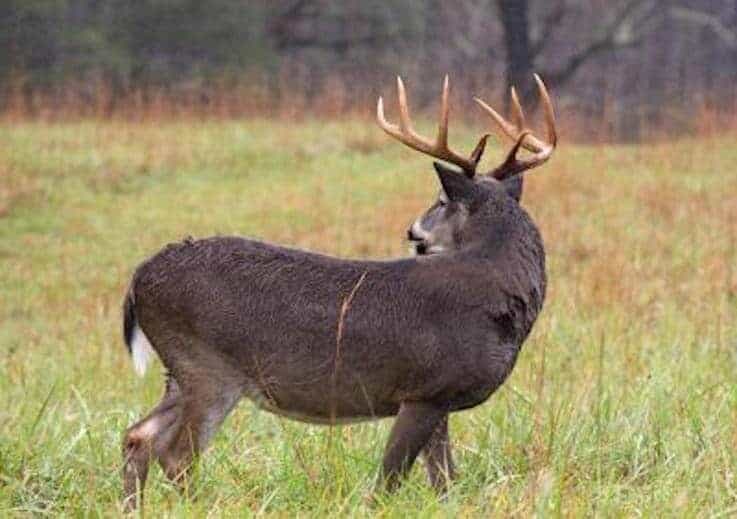
Whitetail Movement During a Clear Day
During a nice clear day, hunting in the mornings and evenings will be your best bet. Although, a clear day may (in theory) be more difficult to hunt than a rainy day. During a rainy day, you can expect deer to move when the rain stops, and thanks to the cell phone in your pocket, you can tell exactly when that will be.
During a clear day, if the barometric pressure is fairly average, you will probably see the most deer in the mornings. Deer will probably be moving in the evening as well, but throughout the day, whitetail may not move that much. With that being said, you should not toss a midday hunt away and only hunt in the mornings and evenings.
Now, I agree that those midday hunts can get fairly boring, but I sit through them anyway. When I go out of state to hunt, I hunt hard. That means, as long as it is not pouring down rain outside, I am probably going to sit all day. From personal experience, I can definitely say that during a clear day I see the most deer in the mornings and quite a few in the evenings from about 3 pm to dark.
However, around 11 am to 3 pm can be dreadfully dry and boring. That does not mean that I have not seen deer during the day though, because I have seen and killed plenty during midday. The only way to know if you will see deer is to stick it out and hunt as much as possible.
Pre-rut and post-rut will follow what I talked about here, although, during prime time, deer will be running everywhere during the morning, midday, and evening. Those first two weeks of November are the best, and if the weather is bearable, I am staying out all day.
Whitetail Movement During an Cloudy/Overcast Day
Overcast days are some of the best days to be in the woods. Deer like to move in slightly darker conditions. Why? We have no idea. However, like we just talked about, deer typically do not move as much during midday when the conditions are clear/bright. Although when it is overcast, darker, and cooler, I tend to see more deer move more during that midday timeline.
You can still expect to see the majority of deer in the mornings or evenings, but with an overcast day, you should also expect to see more than normal during the midday hours.
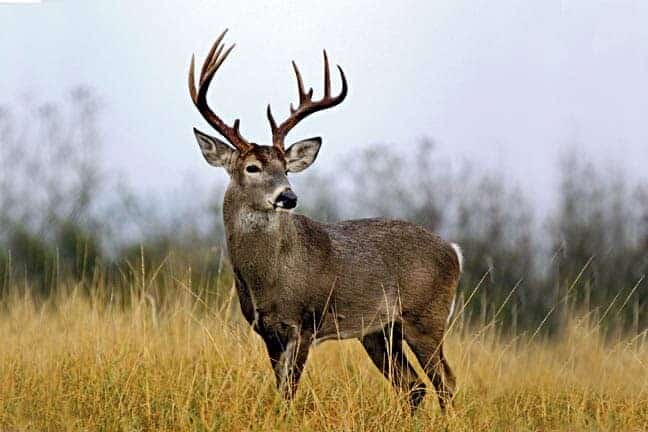
Realtree found that on days of high cloud cover/overcast that deer move less, on average. Although, they only recorded their data from hunters that hunt during the mornings and evenings. They theorized that this was because cloudy days make it harder for deer to see as far, and be able to watch for predators. I do not really believe this. Typically, cloudy days make it easier for me to see deer, plus deer can see very well in the dark. So why would they not be able to see well during a gloomy day? For me, it is easy to conclude that the deer they did not see in the mornings or evenings, chose to move midday instead.
Whitetail Movement During a Rainy Day
Whitetail rely heavily on three of their five senses to stay alive. Those are sight, smell, and hearing. Rain impacts all three of those, but mostly their smell and hearing. Rain will make it harder to smell by masking molecules in the air with water, and harder to hear, obviously, due to the sound of rain hitting the ground. To combat this, deer may go to places where they can use their best sense at that time to its fullest extent, sight. During times of moderate rain, you will probably find more deer in clearings, or fields.
Related Post: Hunting Whitetails in The Rain
Let’s break down the three possibilities: light, moderate, and heavy rains.
- Light Rain – a light rain will not change things too much in terms of deer movement. It may make them stay in their morning beds longer, or move later in the day. They may also be seen traveling to their evening beds a little earlier as well, but all and all, a light rain will not change too much about your hunt.
- Moderate Rain – during a moderate rain, deer will start to behave differently. They will start going out into clearings or fields so they can see better. They may move a little later than normal and will return to their beds sooner than normal. This can be a tough time to sit in the woods, however, many hunters have killed giants in the rain. The only way to know for sure is to be out there watching.
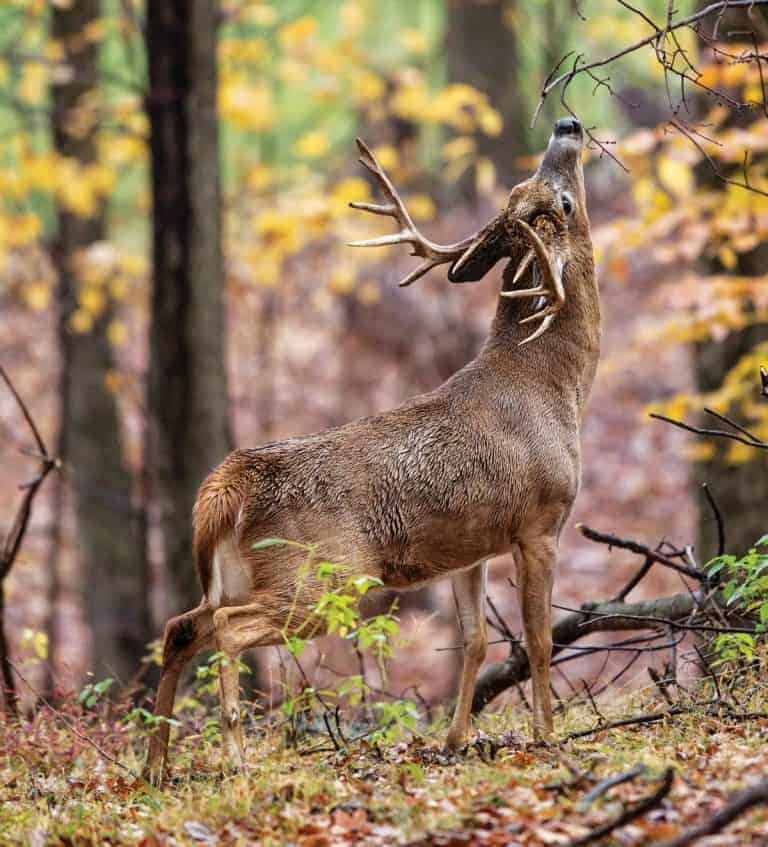
- Heavy rain – during a heavy rain, not much of anything will be moving. It is much harder to see during this heavy rain, and deer will probably stay bedded as long as possible. It is not worth sitting out in a monsoon, you will be lucky to see a single deer.
You can also expect to see deer moving after the rain. When they have been bedded down for 8-12 hours and the rain lets up, you can bet your bottom dollar they are going to be hungry. So, your best bet is to set up around a preferred food source, or a trail that leads from their bedding area to the food source. Bucks will also want to rework their scrapes and rub lines, so make sure you consider those as well.
Whitetail Movement Before & After a Storm
Whitetail deer, like many animals, are able to tell when a storm front is coming well before it gets there. You can expect them to behave differently a day or two before a storm. They will likely feed more heavily, so they do not need to get up during the storm. The day before a storm, you should definitely hone in on preferred food sources, and the trails leading from bedding areas to them. They are going to be hunkering down that evening in their most protected bedding area. So, if you play them right, you can catch them on the way to their beds if you do not find the one you are looking for that morning.
After the storm, whitetails are going to be hungry. You can count on them moving back out to the food sources as soon as the rain lets up. Deer always have to eat, and this also applies during the rut as well. Although bucks may not be as focused on the food as much as they are on the does in the feeding areas when the rut is in full swing.
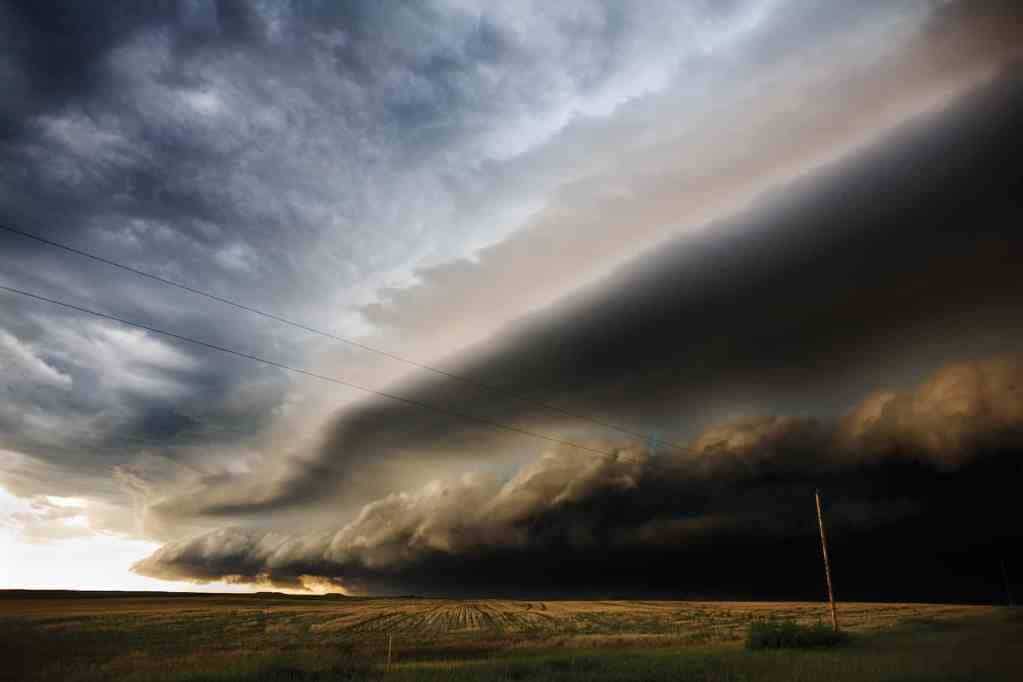
It is not a bad idea to try out a hunting blind, or box stand for this situation. They will keep you dry, and you can get out in the woods just before the storm lets up if it is midday. Which will be better overall, because the deer are likely going to move very soon after the storm lets up. If you are just noticing the storm let up from your hotel room because you were napping, you may have missed the prime time movement.
A storm front will also change barometric pressure, which can also affect how much deer move the day before or after the storm. We will look into pressure and what it entails later.
Whitetail Movement When There Is a Cold Front Coming In
Cold fronts can make some of the best hunting days. It is typically the day or two after the cold front passes that is best for hunting. Just before a cold front, you will see increased winds, overcast, patch rains, and a lower barometric pressure. It is hard to say how deer will move before the front, according to Bone Collector, they are unpredictable at this time. Although, we know how they move afterwards.
When the cold front passes, temperatures will start to stabilize (and will be a bit cooler), the barometric pressure will also increase, and the rain will clear up. With cooler weather, those nocturnal deer are going to be more willing to move throughout the day, instead of waiting for the cool nights.
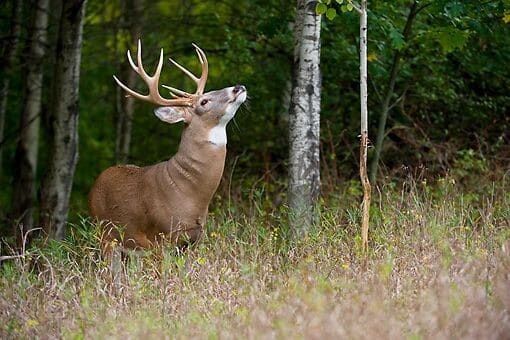
Post-cold front, you will start to see deer move much more than before. A day or two following the end of the front, they will focus more on feeding during the day. Whitetail bucks will focus on feeding as well as pre-rut and rut activities such as working rub and scrape lines.
The best place to be during the first morning is close by a buck bedding area, with a grunt tube in hand. Let out a few blind grunts and wait for that buck to come out. He will more than likely want to check you out on his way to feed or make a scrape. That evening, your best bet is to sit by a food source or a trail leading from a food source to a bedding area. Deer will be moving earlier and more frequently than normal during this evening, making it one of the best times to be in the woods.
Whitetail Movement During Days of High and Low Wind
Windy days can be a good thing and a bad thing at the same time. Wind makes it more difficult for whitetail to use their senses. Whitetail are not going to be able to smell as well, and their sight is also impacted due to all the foliage swaying back and forth. With that being said, deer are still going to move when it is windy. There was actually a study at Penn state that concluded deer move more on windy days, so let’s break down why.
Windy Days
Deer are always going to be hungry. They will feed throughout the day with wind or not, within reason. Plus, it is not always super windy everywhere. You may find more deer traveling down valleys and staying away from ridges or hill tops so that they can avoid the wind. Deer are well suited for the cold, but they are not impervious to it. They have to get out of that super high wind when it is cold out or else they could suffer the health effects to come.
You can also expect deer movement to sharply increase once the high wind calms down. After the wind slows down, deer are going to feel more comfortable and start to feed again. So, if it is really windy one evening and throughout the night, you should expect the next morning to be promising if the wind dies down.
Dead, Still Days
A lot of hunters hate going out to the stand during days where there is zero/minimal wind. For me, it is still worth going. Dead still days can be hard to hunt, but the deer do not really mind them. These types of days are not going to affect their patterns. The only adjustment you need to make is being more careful with your movement. When there is a normal amount of wind, you can get away with a bit of movement because it goes with the wind. However, if nothing in the woods is moving, it can be difficult to stand up and draw back on a whitetail without being seen.
Keeping the Moon in Mind
Moon phases are a hazy subject in deer hunting. A large number of hunters and brands wholeheartedly believe the moon has drastic effects on deer movement. The only problem is that every experiment that has been conducted on this subject has not found a correlation between moon phase and deer movement.
The big idea is that during phases where the moon is the darkest, deer will move less at night due to decreased visibility. So by default if they move less at night, they must move more during the day. Personally, I do not hunt based purely off the moon. Although, you may be able to predict when deer will move a little earlier or later in the mornings or evenings based on how the moon is.
Here is what Mossy Oak has to say about hunting the moon,
Effects of Barometric Pressure on Whitetail Movement
If you are not super serious about deer hunting, barometric pressure, a.k.a air pressure, may not be something you ever considered. Typical barometric pressure is around 30 in-Hg. As it turns out, whitetail like pressures a tad higher than 30. The pressure helps tell them when bad weather is coming, so they know when to get up and feed. Barometric pressure will fluctuate between 28 and 32 in-Hg at most. If you are wondering what that unit is, it is inches of mercury.
During days when pressure is around 30.2-30.5, deer are known to move considerably more than normal. On the other hand, when pressure drops to around 29.8-29.5, deer movement drops by 66% relative to a day of 30 in-Hg pressure. These changes in pressure are caused by the weather and whichever front is coming in or going out at the time. Cold fronts are known to decrease pressure before they arrive, and increase pressure once they pass.
Check out my other post for a more detailed analysis of hunting based on barometric pressure.
Barometric pressure is only one factor that goes into the complicated game of deer movement. Although it should not be overlooked and can be a good indicator of movement to come.
Conclusion
So as you just learned, the weather can have major effects on the way whitetail deer like to move. Sometimes they prefer to move during the day, and other times they prefer to move during the mornings and evenings. As long as you remember the general rules we went over here and know what the weather is going to be like on your hunting days, you should have a good idea of how and where to hunt. All it could take is one cold front, or rainy day to get that big buck out of his bed during the day, and I hope you are out there to capitalize on it.
Thank you for reading my article about when whitetail are most active. I hope you enjoyed it and learned something you didn’t already know. If you like my content, subscribe to my weekly update. If you have any other questions about when whitetail are active or just want to connect, feel free to email me at [email protected].

